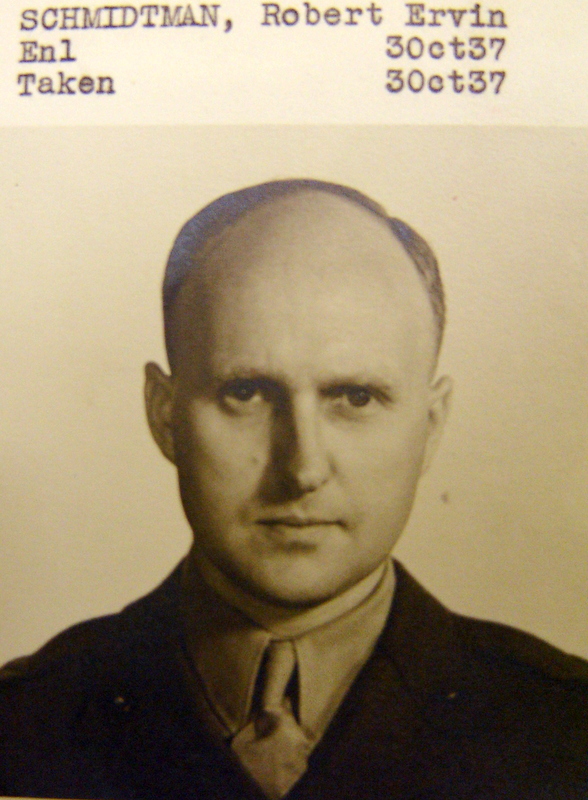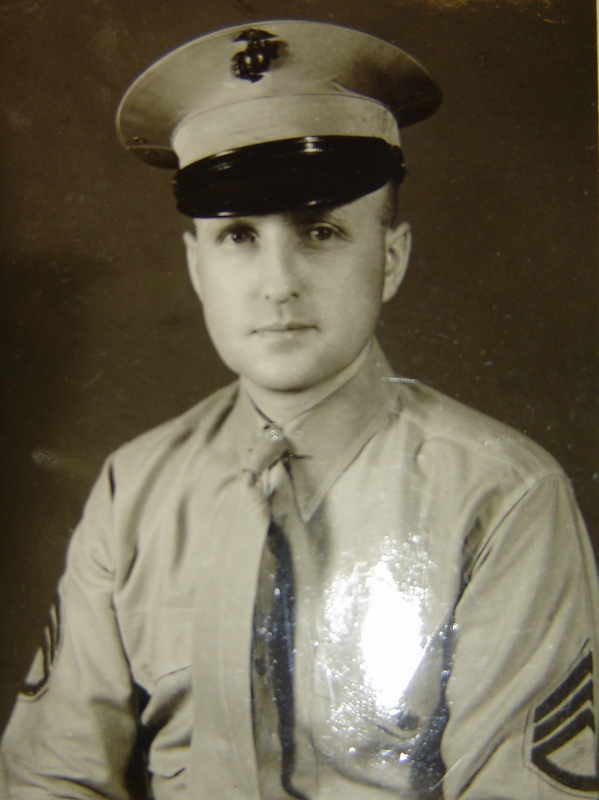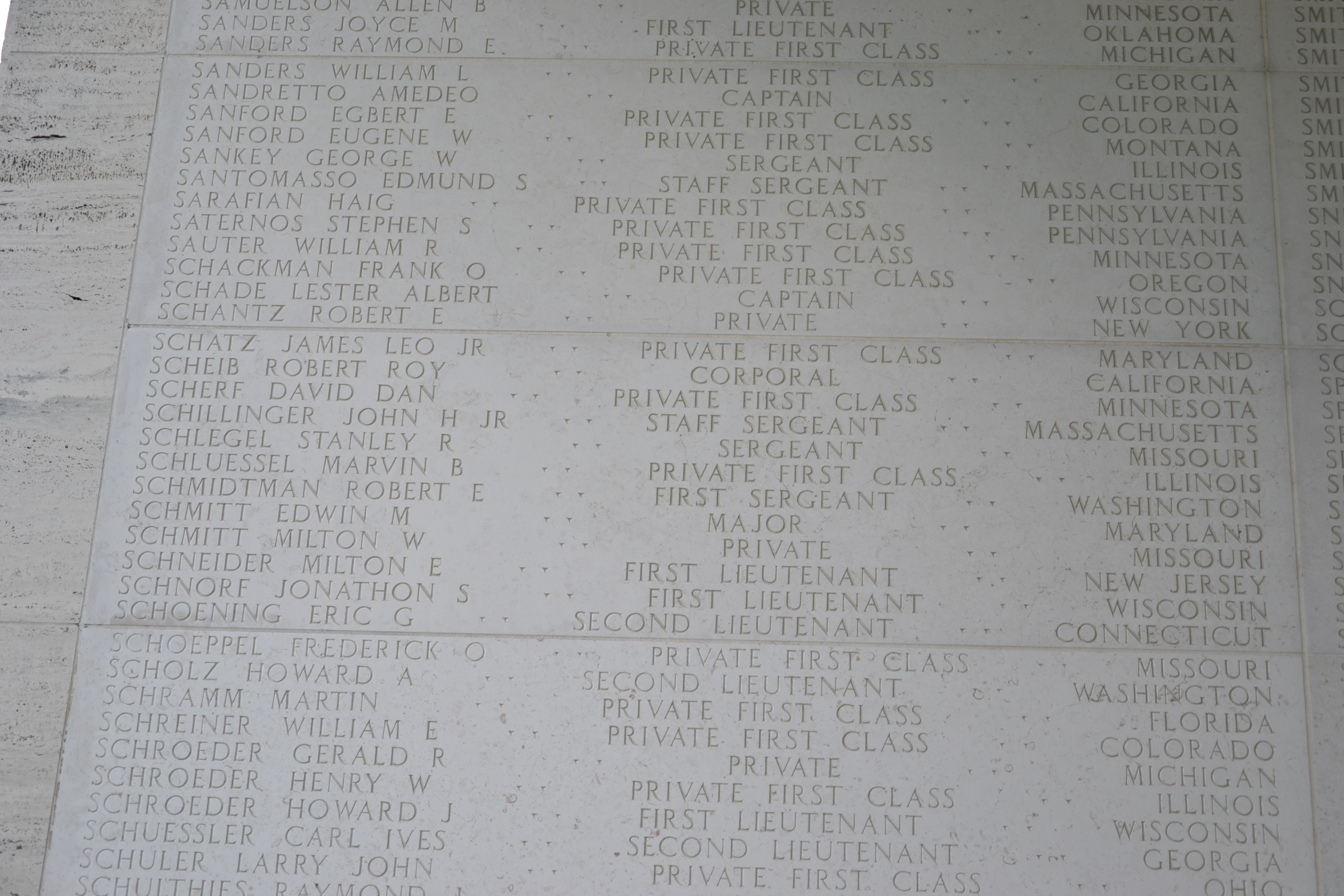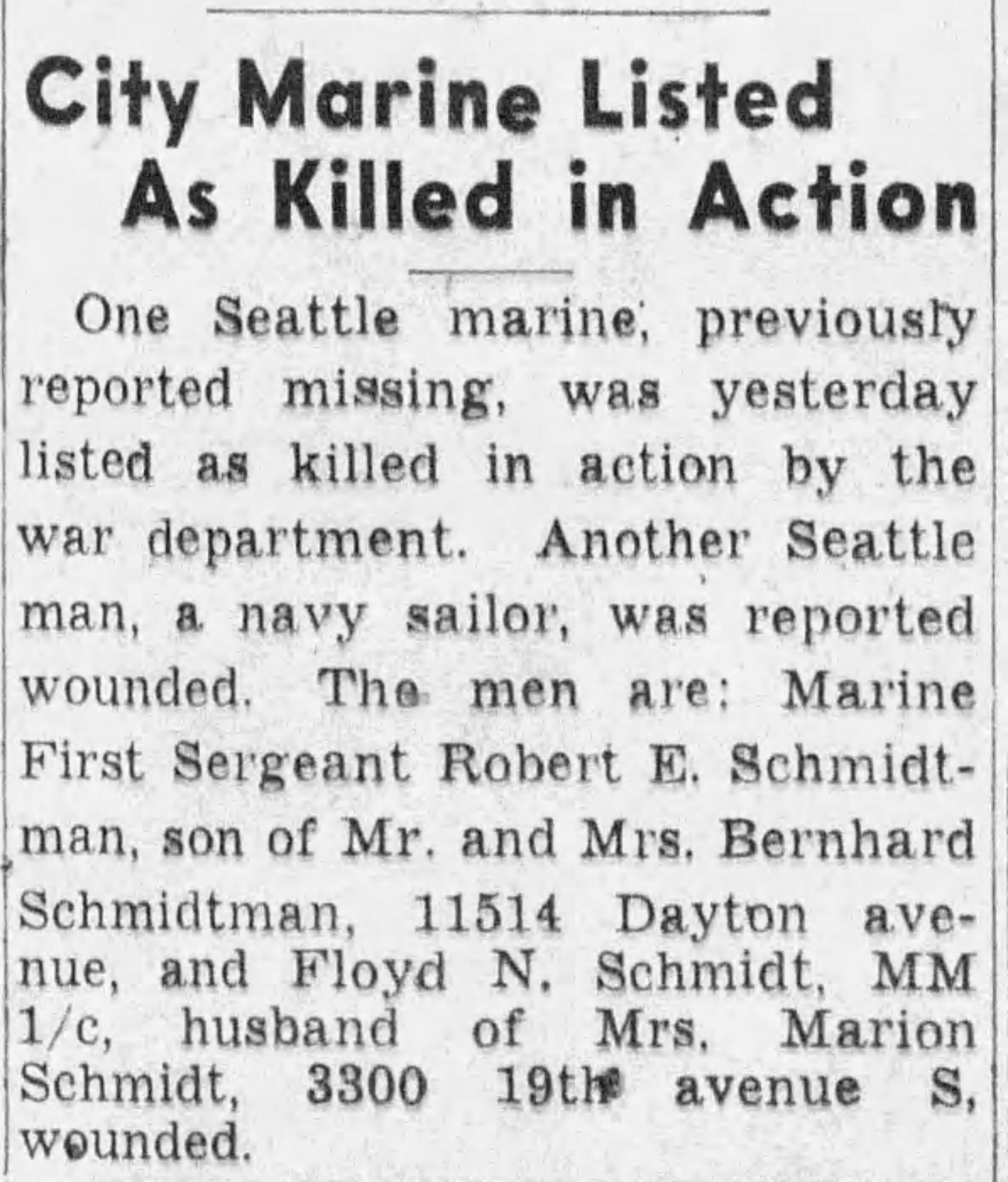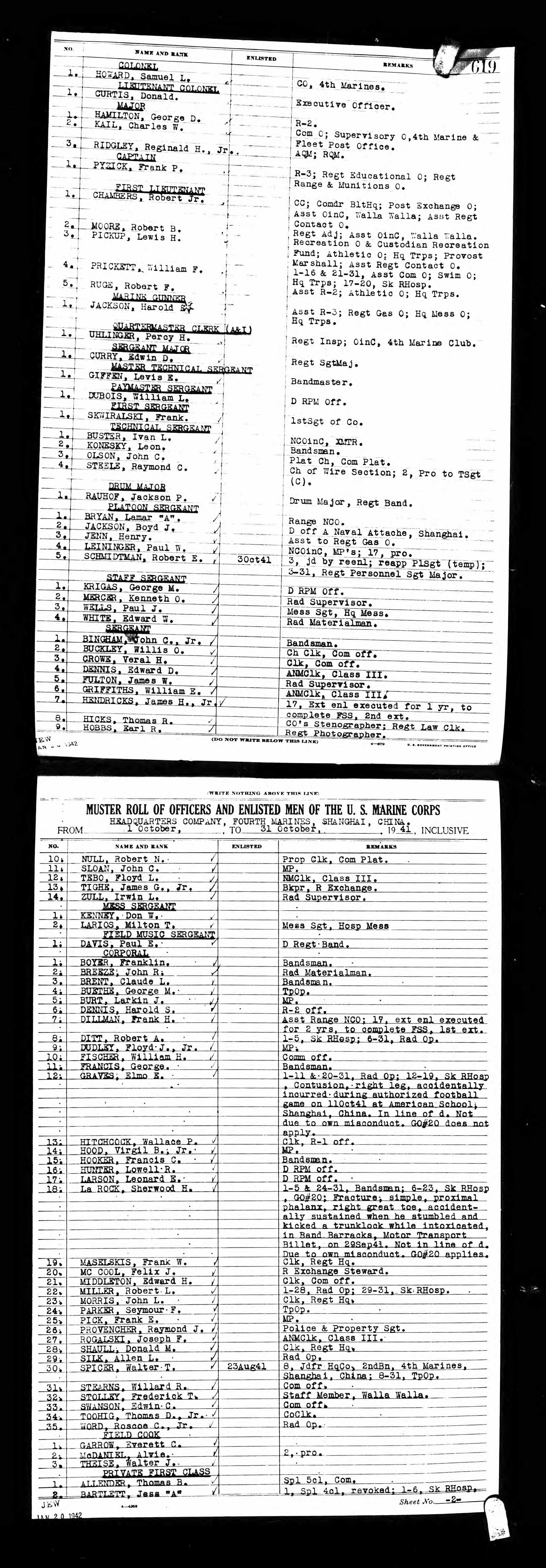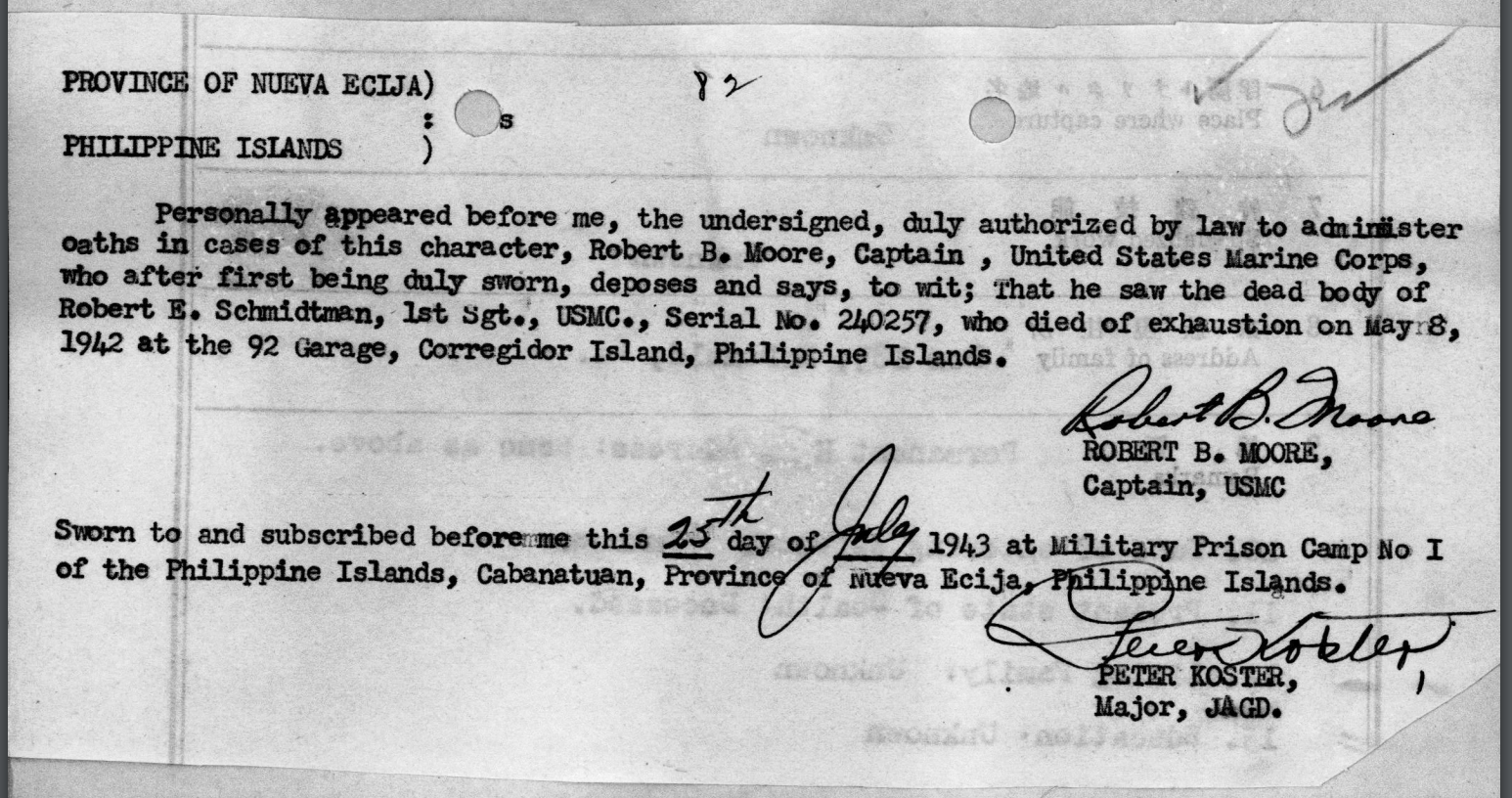After graduation from high school, Schmidtman attended the Griffin-Murphy Business College in Seattle, Washington.
1stSgt Schmidtman joined the Marine Corps on October 3, 1933. After completing his training at the Marine Corps Recruit Depot (MCRD), San Diego, California, then Private Schmidtman was assigned to a post at once impressive and intimidating to a young private – clerk to the most fearsome enlisted man at the recruit depot, Sergeant Major William Harrmann, a position he held for the next two years. He was promoted to Private First Class in March of that year and then Corporal by September. Corporal Schmidtman was by then clerking for Lieutenant Colonel Harry L. Smith. In December 1936 then Cpl Schmidtman was transferred from his job at MCRD. He was promoted to Sergeant and was sent to a posting at Headquarters, Western Recruiting Division in San Francisco, California. He would spend the next four years on recruiting duty with a brief tour on the drill field back at MCRD. In August, 1940 Sgt. Schmidtman shipped out for an overseas assignment, arriving at Cavite Navy Yard in the Philippines and assuming the clerk's position in China with the Regimental Headquarters, Fourth Marine Regiment. He was soon promoted to First Sergeant.
The Japanese military's presence in China had grown greatly since they invaded the country and there had been some small altercations between the China Marines and the Japanese. The regiment was greatly outnumbered and the two battalions were greatly undermanned. On November 28, 1941, as the threat of war approached, the 4th Marine Regiment was recalled to the Philippines to prepare defenses against a suspected Japanese invasion. On December 7th, the Empire of Japan attacked Pearl Harbor, Hawaii. On December the 8th, they attacked the Philippines. The overwhelming numbers of attackers coupled with the nearly constant bombing drove the Americans back across the island until they were forced to evacuate to Corregidor.
After Bataan fell, the Fourth Marine Regiment created a Fourth Battalion. It was composed mostly of displaced Army and Navy personnel. Several senior enlisted Marines made up the headquarters element and it is believed 1stSgt Schmidtman was one of them. When the Japanese overwhelmed the defenders of Corregidor on May 6, 1942, First Sergeant Schmidtman was one of the men forced to lay down his arms and surrender. The Japanese marched their Prisoners-of-War (POW) in ranks of 4 abreast, down to the US Army's 92nd Coastal Artillery Garage, then in ruin. On the beach of Corregidor Island where they assembled the POW's at the former motor pool for the 92nd Coast Artillery. Nearly 14,000 prisoners with crowded into the area with very little food and only one small tap to provide water. Sergeant Major Charles R. Jackson wrote in his book, "I AM ALIVE" that he saw the body of First Sergeant Schmidtman at the 92nd Garage. He wrote:
"I saw Dr. Wade (Lieutenant Commander Ernest Wade, Medical Corps, United States Navy), stethoscope around his neck, kneeling over a still figure on a stretcher. He arose, dropped his head to his chest, and shook it slowly from side to side. A stretcher party picked up its burden and headed for the main gate. I knew who they were carrying; First Sergeant Schmidtmann (sic), the personnel Sergeant Major from headquarters Company, 4th Marine Regiment, lay dead on that piece of canvas. Doctor Wade now bent over the next case, taking care of a gasping man".
Apparently the ordeal 1stSgt Schmidtman was being forced to endure was too much for him. He may have died from the deprivations he was being forced to endure or he may have been wounded on Corregidor; there is no known verification of his being wounded however. His personnel record reports he died of heat exhaustion on May 8, 1942. SgtMaj Jackson verified that Schmidtman died at the 92nd Garage. It was reported in his service record book reviewed by this author that the 1stSgt was buried in "Statwan Cemetery".
After the war ended, a White Russian woman calling herself Claudia Schmidtman who was living in Tientsen, China, claimed that she was the wife of 1stSgt Schmidtman. She claimed they were married (apparently in China)and that he had promised to take her to Manila, Philippine Islands, after the war. She also proclaimed that she had a son by the 1stSgt, who was also named Robert Schmidtman (the 1stSgt's personnel file shows this "son" had contacted Headquarters Marine Corps about his father in 1960. The address he used was 94 Byng Street, Orange, New South Wales, Australia). Claudia wrote a letter to Schmidtman's parents proclaiming she was his wife, they had a son, and looked forward to meeting them. After the the American Consulate General in Tiensten received correspondence from Schmidtman's parents regarding Claudia's claim of being their son's wife plus having had a child with him, they opened an investigation into the matter. It was discovered that the "wife" was Claudia Surovtseva and she was married to a Russian man who had deserted her, leaving her with three children. Reportedly, during the time of her husband's absence, Claudia took up with a US Marine and had a child by him. Also, her actual husband returned during the war and had another child with Claudia. The investigation into Claudia included a statement from another woman who worked in a bar in Tientsin called "The Argentina" where Claudia worked under the name "Vera". The woman said "Vera" had moved to Shanghai two previously with two of her children, one of whom was the son of an "American Marine". This author is unaware of any contact between the two families occurring or of the life/death of of Claudia or her son.
First Sergeant Robert Ervin Schmidtman, Sn# 240257, earned the following badges/decorations during his service in the United States Marine Corps (not in order of precedence):
- Purple Heart Medal (Posthumously)
- Combat Action Ribbon
- Marine Corps Good Conduct Medal 2nd Award #99792
- Prisoner of War Medal
- China Service Medal
- Marine Corps Expeditionary Medal (not verified)
- American Defense Medal with Base Clasp
- Asiatic-Pacific Theater of Operations Campaign Medal with one bronze battle/campaign star
- World War II Victory Medal
- Presidential Unit Citation Ribbon
- Philippine Defense Medal with bronze campaign star
- Philippine Presidential Unit Citation Ribbon
- Army Distinguished Unit Badge/Wreath with cluster
After graduation from high school, Schmidtman attended the Griffin-Murphy Business College in Seattle, Washington.
1stSgt Schmidtman joined the Marine Corps on October 3, 1933. After completing his training at the Marine Corps Recruit Depot (MCRD), San Diego, California, then Private Schmidtman was assigned to a post at once impressive and intimidating to a young private – clerk to the most fearsome enlisted man at the recruit depot, Sergeant Major William Harrmann, a position he held for the next two years. He was promoted to Private First Class in March of that year and then Corporal by September. Corporal Schmidtman was by then clerking for Lieutenant Colonel Harry L. Smith. In December 1936 then Cpl Schmidtman was transferred from his job at MCRD. He was promoted to Sergeant and was sent to a posting at Headquarters, Western Recruiting Division in San Francisco, California. He would spend the next four years on recruiting duty with a brief tour on the drill field back at MCRD. In August, 1940 Sgt. Schmidtman shipped out for an overseas assignment, arriving at Cavite Navy Yard in the Philippines and assuming the clerk's position in China with the Regimental Headquarters, Fourth Marine Regiment. He was soon promoted to First Sergeant.
The Japanese military's presence in China had grown greatly since they invaded the country and there had been some small altercations between the China Marines and the Japanese. The regiment was greatly outnumbered and the two battalions were greatly undermanned. On November 28, 1941, as the threat of war approached, the 4th Marine Regiment was recalled to the Philippines to prepare defenses against a suspected Japanese invasion. On December 7th, the Empire of Japan attacked Pearl Harbor, Hawaii. On December the 8th, they attacked the Philippines. The overwhelming numbers of attackers coupled with the nearly constant bombing drove the Americans back across the island until they were forced to evacuate to Corregidor.
After Bataan fell, the Fourth Marine Regiment created a Fourth Battalion. It was composed mostly of displaced Army and Navy personnel. Several senior enlisted Marines made up the headquarters element and it is believed 1stSgt Schmidtman was one of them. When the Japanese overwhelmed the defenders of Corregidor on May 6, 1942, First Sergeant Schmidtman was one of the men forced to lay down his arms and surrender. The Japanese marched their Prisoners-of-War (POW) in ranks of 4 abreast, down to the US Army's 92nd Coastal Artillery Garage, then in ruin. On the beach of Corregidor Island where they assembled the POW's at the former motor pool for the 92nd Coast Artillery. Nearly 14,000 prisoners with crowded into the area with very little food and only one small tap to provide water. Sergeant Major Charles R. Jackson wrote in his book, "I AM ALIVE" that he saw the body of First Sergeant Schmidtman at the 92nd Garage. He wrote:
"I saw Dr. Wade (Lieutenant Commander Ernest Wade, Medical Corps, United States Navy), stethoscope around his neck, kneeling over a still figure on a stretcher. He arose, dropped his head to his chest, and shook it slowly from side to side. A stretcher party picked up its burden and headed for the main gate. I knew who they were carrying; First Sergeant Schmidtmann (sic), the personnel Sergeant Major from headquarters Company, 4th Marine Regiment, lay dead on that piece of canvas. Doctor Wade now bent over the next case, taking care of a gasping man".
Apparently the ordeal 1stSgt Schmidtman was being forced to endure was too much for him. He may have died from the deprivations he was being forced to endure or he may have been wounded on Corregidor; there is no known verification of his being wounded however. His personnel record reports he died of heat exhaustion on May 8, 1942. SgtMaj Jackson verified that Schmidtman died at the 92nd Garage. It was reported in his service record book reviewed by this author that the 1stSgt was buried in "Statwan Cemetery".
After the war ended, a White Russian woman calling herself Claudia Schmidtman who was living in Tientsen, China, claimed that she was the wife of 1stSgt Schmidtman. She claimed they were married (apparently in China)and that he had promised to take her to Manila, Philippine Islands, after the war. She also proclaimed that she had a son by the 1stSgt, who was also named Robert Schmidtman (the 1stSgt's personnel file shows this "son" had contacted Headquarters Marine Corps about his father in 1960. The address he used was 94 Byng Street, Orange, New South Wales, Australia). Claudia wrote a letter to Schmidtman's parents proclaiming she was his wife, they had a son, and looked forward to meeting them. After the the American Consulate General in Tiensten received correspondence from Schmidtman's parents regarding Claudia's claim of being their son's wife plus having had a child with him, they opened an investigation into the matter. It was discovered that the "wife" was Claudia Surovtseva and she was married to a Russian man who had deserted her, leaving her with three children. Reportedly, during the time of her husband's absence, Claudia took up with a US Marine and had a child by him. Also, her actual husband returned during the war and had another child with Claudia. The investigation into Claudia included a statement from another woman who worked in a bar in Tientsin called "The Argentina" where Claudia worked under the name "Vera". The woman said "Vera" had moved to Shanghai two previously with two of her children, one of whom was the son of an "American Marine". This author is unaware of any contact between the two families occurring or of the life/death of of Claudia or her son.
First Sergeant Robert Ervin Schmidtman, Sn# 240257, earned the following badges/decorations during his service in the United States Marine Corps (not in order of precedence):
- Purple Heart Medal (Posthumously)
- Combat Action Ribbon
- Marine Corps Good Conduct Medal 2nd Award #99792
- Prisoner of War Medal
- China Service Medal
- Marine Corps Expeditionary Medal (not verified)
- American Defense Medal with Base Clasp
- Asiatic-Pacific Theater of Operations Campaign Medal with one bronze battle/campaign star
- World War II Victory Medal
- Presidential Unit Citation Ribbon
- Philippine Defense Medal with bronze campaign star
- Philippine Presidential Unit Citation Ribbon
- Army Distinguished Unit Badge/Wreath with cluster
Gravesite Details
Entered the service from Washington.
Family Members
Other Records
Sponsored by Ancestry
Advertisement
Advertisement







